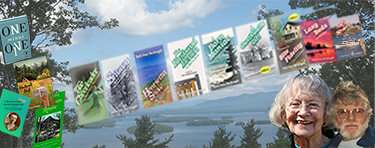
Beginning in 2018 "Ruth's Neighborhood" entries were also posted on Ruth's FACEBOOK page where her entries (usually weekly, on Sunday mornings) lead to lively conversations.
This Page: 2004 - 2007
2007
WINTER OF OUR COMFORT FOOD
September 9, 2007
Winter is definitely a time for comfort food, of course, but last winter we outdid ourselves. It all began with Bev’s meat loaf.
When Winifred Motherwell had visited the previous summer with her daughters, Molly and Lisa, the talk turned to food and Molly and Lisa spoke fondly of Winifred’s meat loaf. Winifred said that her secret ingredient was pork sausage. Eureka! I had been seeking a secret ingredient for Bev’s “famous” meat loaf that plays a role in The Husband Bench or Bev’s Book. My own secret ingredient, a tablespoon of horseradish, wasn’t spectacular enough for Bev. But sausage! I asked Winifred if Bev could possess her secret, and Winifred very kindly said yes and gave me the recipe, which had been her grandmother’s.
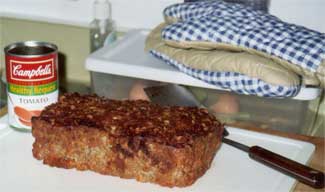 Winter is definitely a time for comfort food, of course, but last winter we outdid ourselves. It all began with Bev’s meat loaf.
Winter is definitely a time for comfort food, of course, but last winter we outdid ourselves. It all began with Bev’s meat loaf.
When Winifred Motherwell had visited the previous summer with her daughters, Molly and Lisa, the talk turned to food and Molly and Lisa spoke fondly of Winifred’s meat loaf. Winifred said that her secret ingredient was pork sausage. Eureka! I had been seeking a secret ingredient for Bev’s “famous” meat loaf that plays a role in The Husband Bench or Bev’s Book. My own secret ingredient, a tablespoon of horseradish, wasn’t spectacular enough for Bev. But sausage! I asked Winifred if Bev could possess her secret, and Winifred very kindly said yes and gave me the recipe, which had been her grandmother’s.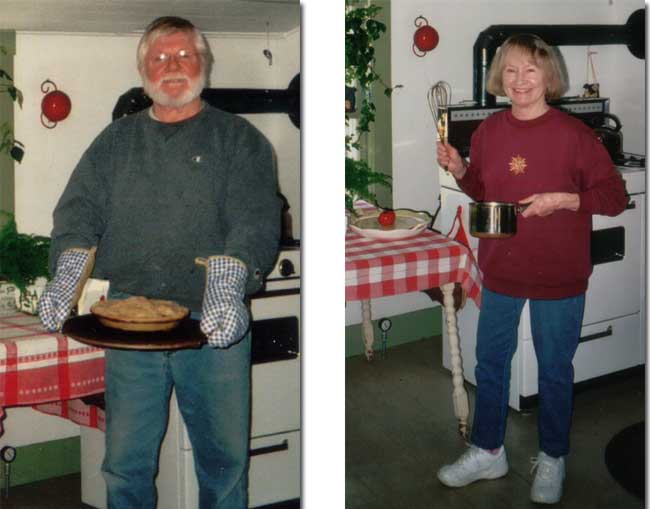
So I had a happy time making the meat loaf. One of the ingredients is tomato soup. Winifred had remarked that her grandmother must have encountered a Campbell’s cookbook, and I remembered that I’d owned one at some stage of my early-married years. This got me taking down from my cookbook shelves other cookbooks from those years, the Better Homes & Gardens looseleaf cookbook, Betty Crocker’s Good and Easy Cookbook, the 1953 edition of The Joy of Cooking my grandmother had given me.
And these led me even further back in time, away from my editions of The Fannie Farmer Cookbook, back to my mother’s 1935 edition of The Boston Cooking-School Cook Book by Fannie Merritt Farmer. This was the cookbook my sister and I learned from, fooling around in the pantry where the breadboard and rolling pin were always handy even after our mother realized that she could get away with Table Talk Pies and stopped making her own.
Pies. I too have stopped making my own. Last winter Don decided that if the only way he could get a homemade pie was to do it himself, he would forge ahead. But piecrust? He remembered his mother casually preparing and rolling out dough. However, when he delved into my cookbooks he found the piecrust recipes as daunting as my tales of messy cleanups of flour. Then Penny, my sister, confided that Pillsbury piecrust is great.
First, we made tourtière, a meat pie, another recipe of Bev’s, adapted from a recipe that Penny had acquired long ago from Bea Joyal, her mother-in-law. I did the filling, and Don followed the Pillsbury directions—just unroll, as it says on the package. After the triumph of this collaboration, he graduated to making an apple pie entirely on his own; well, with only the help of the Pillsbury doughboy.
Meanwhile, I had rediscovered cream sauces. Over the years I’ve made them occasionally, in recent years substituting olive oil for butter and skim milk or Land O’Lakes fat-free half-and-half for milk or cream, out of concern for Don’s heart, but last winter it seemed as if I made this heart-healthy version wore out my wire whisk! In The Boston Cooking-School Cook Book I found the recipe my mother used for Salmon Wiggle. So we had that on toast, and we also had another old favorite, creamed cod on baked potatoes. There was creamed crabmeat on toast too, and even that military standby, creamed chipped beef. We had Chicken à la King and I told Don to pretend he was at a ladies’ luncheon.
Then spring and summer came, and my thoughts turned to salads. Now winter is approaching. I’m wondering about searching out my old (circa 1960s) recipe for onion-soup pot roast, and Don is talking about making his mother’s famous bran rolls. Then there’s the “snowball” trifle-type concoction of angel-food cake and whipped cream and coconut that his mother made every Christmas . . .
Bev’s recipes for meat loaf and tourtière are in The Husband Bench or Bev’s Book.
Photos by Don and Ruth MacDougall
© 2007 by Ruth Doan MacDougall; all rights reserved.
REBUILDING THE DANIEL DOAN TRAIL
July 16, 2007
This entry includes many photos, so is available as a PDF for your convenience.
MY HUSBAND IS IN LOVE
WITH MARGARET WARNER
May 10, 2007
I didn’t find telltale lipstick stains or billets-doux. Instead, whenever I walked through the living room while Don was watching PBS’s NewsHour with Jim Lehrer, I kept finding him staring with rapt attention at Senior Correspondent Margaret Warner, hanging on her every word.
While watching this program, Don usually reads a newspaper or magazine at the same time, a habit of his with many television programs. (Years ago I discovered him reading the Atlantic Monthly and watching Hee Haw. He explained, “It kind of takes the edge off each.”) But I realized that if Margaret Warner was on the screen, he dropped his reading material and concentrated on her.
Finally I confronted him. “What,” I asked, “is going on between you and Margaret Warner? What has she got that I haven’t got?
”
He didn’t try to hide his infatuation. People in love need to talk about the object of their affections. He said, “Margaret should be running the world. She is queenly. She is statesmanlike. Judy Woodruff is intense, but Margaret is Margaret. When she interviews somebody, she never argues or pushes a point. She just sets out her little wires for the person to trip over. I am enamored.”
I retreated, knowing that I couldn’t compete with this rival and wondering what I was reminded of. Some song with a line about clutching a loved one’s briefcase— Aha! I remembered a young Carol Burnett on TV singing “I Made a Fool of Myself over John Foster Dulles.”
Don must be possessed by the same grand passion as Carol.
© 2007 by Ruth Doan MacDougall; photos © 2007 by Ruth Doan MacDougall; all rights reserved
CHAIR-CANING
January 28, 2007
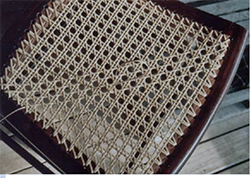 Don has been recaning our dining-room chairs. Watching him at this intricate work, something I could no more do than fly, I decided that his years of chair-caning experience might be helpful to others interested in trying it, and I announced that I was going to interview him. He looked taken aback. But I produced a notepad and began asking questions.
Don has been recaning our dining-room chairs. Watching him at this intricate work, something I could no more do than fly, I decided that his years of chair-caning experience might be helpful to others interested in trying it, and I announced that I was going to interview him. He looked taken aback. But I produced a notepad and began asking questions.
Ruth the Roving Reporter: What was the first chair you ever caned?
Don: The one for my rolltop desk.
Ruth: Oh yes. When we were living in Lisbon [New Hampshire, not Portugal!], so that would’ve been circa 1962?
Don: I suppose. I did it in plastic because I had no idea what I was doing and thought that plastic would be less likely to break while being worked with. It’s actually more likely to break during the work by cutting itself, sawing itself. A plastic seat is a lot stronger than a real cane seat, though a cane seat is very strong if done properly.
Ruth: How did you learn how to cane? From that place in Connecticut?
Don: I discovered the H.H. Perkins Company in North Haven, Connecticut, probably from some magazine ad. Maybe Yankee magazine? At that time they supplied a free instruction booklet with each order, and that’s how I taught myself. They have a Web site now, www.hhperkins.com. And now there’s a new company I also use, Connecticut Cane and Reed in Manchester, Connecticut.
Ruth: What’s the hardest part about caning?
Don: Well, knowing how to do chair repairing is a big advantage. Anyone who’s going to do much caning had better learn something about regluing chairs and repairing and refinishing them.
Ruth: That’s a nice transition, because I was going to ask you next about the different kinds of seats you wove when you were doing furniture repair.
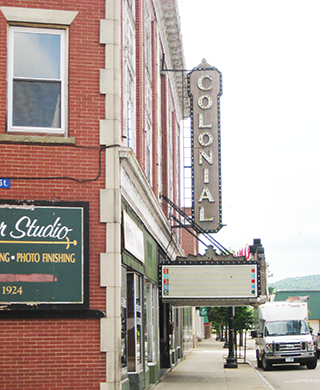 [In the 1980s, we turned our dining room into a workroom, and in this and the cellar Don had a furniture repair and restoration business. Chairs were such a big part of it that we were tempted to get esoteric and call it “Three Chairs,” from Thoreau’s comment in Walden: “I had three chairs in my house: one for solitude, two for friendship, three for society.” Eventually Don decided that in order to make an adequate profit he needed more space than we had or could afford, so he phased out that business and we increased the caretaking business.]
[In the 1980s, we turned our dining room into a workroom, and in this and the cellar Don had a furniture repair and restoration business. Chairs were such a big part of it that we were tempted to get esoteric and call it “Three Chairs,” from Thoreau’s comment in Walden: “I had three chairs in my house: one for solitude, two for friendship, three for society.” Eventually Don decided that in order to make an adequate profit he needed more space than we had or could afford, so he phased out that business and we increased the caretaking business.]
Don: I guess I’ve done almost all kinds. Fiber rush seating isn’t my favorite. I’ve never done a real rush seat, which I think would take some hands-on instruction unless you have a great deal of patience.
Regular caning looks more complicated but it isn’t really, once you grasp the basics.
One of the easiest and most satisfying is Shaker woven tape. It’s simple to do and very strong. The only problem comes with sewing the tapes together, which of course can’t be done on a machine. Staple them if you can find stainless steel staples; regular staples will rust.
Ash splint seats are beautiful when they get worn a bit. But ash splint requires more soaking than most. And the joints between splints can be irritating to do. I devised my own joint method by making an arrowhead-and-slot connection, using a large-diameter paper punch.
Then there are prewoven web seats, an attempt by chair manufacturers to speed up the procedure by using a spline to hold the cane into a groove in the seat. However, it takes careful preparation of the groove and careful soaking of the prewoven cane. The prewoven seats are most commonly seen as canoe seats—and if you’re going to try prewoven seats, this is a good place to start. Canoe seats are small.
Ruth: With our dining-room chairs, you’ve done all but one in the same pattern. Do the patterns have names?
Don: The basic weave is usually called seven-step. (photo, above) It’s the one almost everybody does. It can become boring, but you get so you can do it without too much thought. You do have to stay somewhat alert, because every chair seat is different. Except for those that aren’t.
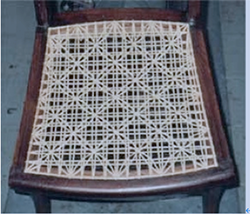 For variety, I did your dining-room chair in the pattern called daisy chain. (photo, below) With our fiftieth anniversary coming up next fall, I thought I’d better do something personal.
For variety, I did your dining-room chair in the pattern called daisy chain. (photo, below) With our fiftieth anniversary coming up next fall, I thought I’d better do something personal.
Ruth: [Emotional noises.]
Don: There are books about caning fancy seats, intended for experienced caners—and they mean experienced.
Ruth: Do you have any other general thoughts and helpful hints?
Don: The easiest chair to do is one that’s square or rectangular. Of course I’ve never seen a chair that’s absolutely square or rectangular. The more difficult caning is for chairs that have somewhat rounded seats. An absolutely round seat would be quite easy, but I’ve never seen one of those either.
When you do a chair, try to do one that still has the seat in it. Before you remove the old seat, study it thoroughly and/or photograph it, so you can see what was done. Keep in mind this doesn’t mean they did it correctly.
The biggest disagreement among caners seems to be what to do when you finish caning, whether or not to treat the seat in some manner. I’m on the don’t-treat side. It’s nice to see a freshly woven seat, and it will age gracefully, as we all do.
© 2007 by Ruth Doan MacDougall; all rights reserved
Photos by Don MacDougall; © 2006; all rights reserved
2006
The End of Our Rope
December 1, 2006
I don’t usually leave clothes overnight on the clothesline, especially when the nights are getting cold and the clothes might freeze on, but one evening in late October after a hectic day I said the hell with them.
The next morning when we looked out the kitchen windows, we saw a large beaver emerging from the pond out back and purposefully lumbering (I choose this verb with deliberation) under the clothesline into the woods behind the toolshed. The clothesline is the reel type, hooked to the side of the house at one end and to a big pine at the other. The night had been windy. I noticed that a sock had blown off the line onto the lawn and assumed that, as a sort of corollary to Murphy’s Law, it would of course be one of Don’s newest pair, not some ancient worn-out sock. I decided against running out and rescuing it right then, so I wouldn’t frighten the poor dear beaver.
Then through the trees we saw that the beaver was cutting down a sapling very near the shed. The woods around our lawn have been depleted since the beavers moved in and changed our little brook to a series of ponds, cutting down trees for dams and for food, but Don has protected the trees we really want spared by wrapping wire mesh around their trunks.
(That old verse comes often to mind: “Woodman, spare that tree! Touch not a single bough! In youth it sheltered me, And I’ll protect it now.”)
This sapling and most of the others in the shed area weren’t protected. Mesmerized, we watched the beaver at work, fearing the sapling would hit the shed when it toppled.
It didn’t. As the beaver began dragging it out, wrestling it through the underbrush, waddling back to snip off a couple of snagged branches, we worried next about the clothesline. Would the remaining branches reach up far enough to become entangled? If they did, would the pressure pull the hook out of the side of the house, or maybe pull part of the house out? I also fretted that the sock on the lawn would get caught in the branches and be borne off and we’d have to buy Don a new pair. The beaver got the sapling safely under the clothesline, missed the sock, dragged the trunk into the pond, and began more manuevering to haul it around rotting logs and other such obstacles, then swam with it out to the open water and on to the outskirts of the lodge, where the beaver family has been storing their winter food supply by driving the cut ends of small trees into the pond’s bottom. This sapling joined the larder.
We were tired out just by watching and worrying. But the beaver lived up to its “busy” adjective by immediately swimming back to the same spot on the lawn, taking the same route under the clothesline, and harvesting another sapling, repeating the same maneuvers, once again sparing the shed, the clothesline, and the sock.
By then it was full morning. Beavers aren’t naturally nocturnal—they came to prefer to work at night because of man’s trapping them, especially during the fashion for beaver hats that nearly caused their extinction—and we see them sometimes awake and working as early as three o’clock in the afternoon or staying up as late in the morning as nine o’clock. At nine this morning, this beaver retired for a well-earned good day’s rest.
We retrieved the laundry, including the sock. While I put everything in the dryer, Don pondered what to do. There were still several tasty-looking saplings around the shed, and no doubt the beaver would return for them. The shed and the clothesline remained at risk.
Eventually Don decided that the trees that could do real harm if they fell on the shed or clothesline or became entangled in the clothesline were those already protected by wire mesh. So he simply unhooked the clothesline from the house, leaving it lying on the grass, attached at the pine-tree end, ready to be rehooked whenever I needed it.
The next morning he looked out the kitchen-sink window and shouted (appropriately), “Damn!”
I rushed to see. The beaver wasn’t there but obviously had been. The clothesline was floating in the pond at the edge of the lawn.
Don said, “I should have unhooked the whole thing and brought it indoors.”
Outdoors we went. Near the shed were more beaver-cut stumps. The beaver had done another lumbering operation, but this time one of the saplings must have got tangled up in the clothesline.
Don pulled the clothesline out of the pond. It had been bitten into three lengths.
© 2006 by Ruth Doan MacDougall; all rights reserved.
Archive of Past Entries
2025
Red-Flannel Hash, Etc.
Family Recipes
Wider Eyelids
Donuts After Dartmouth
Castle in the Clouds
Dan Doan's Birthday
File Folders
Chocolate Lovers' Month
Piano Songs
Titles
Velveeta, etc.
Sandwich Board Greets 2025
Words
2024
PW 2025 Spring Preview
Christmas Vacation
Songs
D-H Trip
Gatsby & Icarus & Pudding
Yankee
Sides
E-BLAST and Sandwich Board
Sentimental Journey
Announcement & Creme Tea
Rosemary Schrager
British Picnic
Fall Food
September Sandwich Board
Soap and Friends
Autumn Anxiety
From Philosophy to Popsicles
Cheat Day Eats
Meredith NH
1920s Fashions
Old Home Week 2024
Honor System
Lost . . .Found . . .
Picnics
Aunt Pleasantine
Best of New Hampshire
Soup to Doughnuts
Tried and True Beauty. . .
A Shaving Horse, Etc.
Farewell, Weirs Drive-In
Backyard Sights
Thoreau and Dunkin’ Donuts
Cafeteria-and-Storybook Food
Lost and Found
Dandelions and Joy
Fiddleheads and Flowers
Pass the Poems, Please
Pete
Road Trip
Reviews and Remarks
Girl Scouts
Board, Not Boring
Postholing & Forest Bathing
Chocolate
PW's Spring Previews
From Pies to Frost
Island Garden
More Sandwich Board
Nancy
2023
Spotted Dick
Dashing Through the Cookies
Chocorua
Senior Christmas Dinner
The Sandwich Board
Nostalgia
Socks, Relaxation, and Cakes
Holiday Gift Books
Maine
Cafeteria Food; Fast Food
Happy 100th Birthday, Dear LHS
Giraffes, Etc.
A Monday Trip
Laconia High School, Etc.
Christmas Romance
National Potato Month
Globe
Preserving With Penny
Psychogeography
Bayswater Books
"Wild Girls"
Kitchens
Old Home Week
The Middle Miles
Bears, Horses, and Pies
Fourth of July 2023
Lucy and Willa
Frappes, Etc.
Still Springtime
In the Bedroom
Dried Blueberries
More Items of Interest
Fire Towers
Anne, Emily, and L.M.
Earthquake,Laughter, &Cookbook
Springtime and Poems
Cookbooks and Poems
Items and Poems
Two Pies
Audiobooks
The Cheeleader: 50th Anniversary
The Lot, Revisited
Penny
Parking and Other Subjects
Concord
Bird Food & Superbowl Food
The Cold Snap
Laughter and Lorna
Tea and Digestive Biscuits
Ducks, Mornings, & Wonders
Snowflakes
A New Year's Resolution
2022
Jingle Bells
Fruitcake, Ribbon Candy &Snowball
Christmas Pudding
Amusements
Weather and Woods
Gravy
Brass Rubbing
Moving Day
Sandwiches and Beer
Edna, Celia, and Charlotte
Sandwich Fair Weekend
More Reuntions
A Pie and a Sandwich
Evesham
Chawton
Winter's Wisdom?
Vanity Plates
2022 Golden Circle Luncheon
Agatha and Annie
National Dog Month
The Chef's Triangle
Librarians and Libraries
Clothes and Cakes
Porch Reading
Cheesy!
The Summer Book
Bears Goats Motorcycles
Tuna Fish
Laconia
More Publishers Weekly Reviews
Shopping, Small and Big
Ponds
The Lakes Region
TV for Early Birds; An April Poem
Family; Food; Fold-out Sofas
Solitary Eaters
National Poetry Month
Special Places;Popular Cakes
Neighborhood Parks
More About Potatoes and Maine
Potatoes
Spring Tease
Pillows
Our Song
Undies
Laughter
A Burns Night
From Keats to Spaghetta Sauce
Chowder Recipes
Cheeses and Chowders
2021
The Roaring Twenties
Christmas Traditions
Trail Cameras
Cars and Trucks
Return?
Lipstick
Tricks of the Trade
A New Dictionary Word
A 50th Reunion
Sides to Middle" Again
Pantries and Anchovies
Fairs and Festivals
Reunions
A Lull
The Queen and Others
Scones and Gardens
Best Maine Diner
Neighborhood Grocery Store; Café
A Goldilocks Morning_& More
Desks
Sports Bras and Pseudonyms
Storybook Food
Rachel Field
The Bliss Point
Items of Interest
Motorcycle Week 2021
Seafood, Inland and Seaside
Thrillers to Doughnuts
National Trails Day
New Hampshire Language
Books and Squares
Gardening in May
The Familiar
Synonyms
"Bear!"
Blossoms
Lost Kitchen and Found Poetry
More About Mud
Gilbert and Sullivan
St. Patrick's Day 2021
Spring Forward
A Blank Page
No-Recipe Recipes
Libraries and Publishers Weekly
Party; Also, Pizza
Groundhog Day
Jeeps
Poems and Paper-Whites
Peanut Butter
Last Wednesday
Hoodsies and Animal Crackers
2020
Welcome, 2021
Cornwall at Christmastime
Mount Tripyramid
New Hampshire Pie
Frost, Longfellow, and Larkin
Rocking Chairs
Thanksgiving Side Dishes
Election 2000
Jell-O and Pollyanna
Peyton Place in Maine
Remember the Reader
Sandwich Fairs In Our Past
Drought and Doughnuts&
Snacks
Support Systems, Continuing
Dessert Salads?!
Agatha Christie's 100th Anniversary
Poutine and A Postscript
Pandemic Listening & Reading
Mobile Businesses
Backyard Wildlife
Maine Books
Garlic
Birthday Cakes
A Collection of Quotations
Best of New Hampshire
Hair
Learning
Riding & "Broading" Around Sunday Drives, Again
The Passion Pit
Schedules & Sustenance
Doan Sisters Go to a British Supermarket
National Poetry Month
Laconia
Results
Singing
Dining Out
Red Hill
An Island Kitchen
Pandemic and Poetry
Food for Hikes
Social Whirl in February
Two Audiobooks & a Magazine
Books Sandwiched In
Mailboxes
Ironing
The Cup & Crumb
Catalogs
Audiobook Travels
2019
Christmas Weather
Christmas in the Village
Marion's Christmas Snowball, Again
Phyliss McGinley and Mrs. York
Portsmouth Thanksgiving
Dentist's Waiting Room, Again
Louisa and P.G.
The First Snow
Joy of Cooking
Over-the-Hill Celebration
Pumpkin Regatta
Houseplants, New and Old
Pumpkin Spice
Wildlife
Shakespeare and George
Castles and Country Houses
New Hampshire Apple Day
Maine Woods and Matchmaking
Reunions
Sawyer's Dairy Bar
Old Home Week
Summer Scenes
Maine Food
Out of Reach
This and That, Again
The Lot
Pizza, Past and Present
Setting Up Housekeeping
Latest Listening and Reading
Pinkham Notch
A Boyhood in the Weirs
The Big Bear
It's Radio!
Archie
Department Stores
Spring Is Here!
Dorothy Parker Poem
National Library Week, 2019
National Poetry Month, 2019/a>
Signs of Spring, 2019
Frost Heaves, Again
Latest Reading and Listening
Car Inspection
Snowy Owls and Chicadees
Sandwiches Past and Present
Our First Date
Ice Fishing Remembered
Home Ec
A Rockland Restaurant
Kingfisher
Mills & Factories
Squirrels
2018
Clothesline Collapse
Thanksgiving 2018
Bookmarks
A Mouse Milestone
Farewell to Our Magee
Sistering
Sears
Love and Ruin
A New Furnace
Keene Cuisine
A Mini-Mini Reunion
Support System
Five & Ten
Dining Out Again
Summer Listening
Donald K. MacDougall 1936-2018
Update—Don
Telling Don
Don's Health
Seafood at the Seacoast?
Lilacs
Going Up Brook, revisited
The Weirs Drive-In Theater
The Green and Yellow Time
Recipe Box and Notebook
Henrietta Snow, 2nd Printing
Food and Drink Poems
Miniskirts & Bell-Bottoms
The Poor Man's Fertilizer
The Galloping Gourmet
The Old Country Store
The entries below predate Ruth's transferring her use of Facebook. They appeared as very occasional opportunities to share what was of interest to her in and around her neighborhood.
2014 - 2017
Book Reviewing
April Flowers
April Snowstorm
Restoring the Colonial Theater
Reunion at Sawyer's Dairy Bar
Going to the Dump
Desks
A Curmudgeon's Lament
Aprons
Our Green-and-Stone-Ribbed World
Playing Tourist
2012-2013
Sawyer's Dairy Bar
Why Climb a MountIn
Penny'S Cats
Favorite Books
Marion's Christmas Snowball
Robin Summer
Niobe
Mother West Wind
Neighborhood Stoves
2008 - 2011
The Lot
Mother Goose
Colonial Theater
Aeons of Ironing
Our Canterbury Tale
Love it Here
Children of the Great Depression
Loads of Laundry
2004 - 2007
The Winter of Our Comfort Food
Rebuilding the Daniel Doan Trail
My Husband Is In Love with Margaret Warner
Chair Caning
The End of Our Rope
The Weirs
Frost Heaves
Where In the World is Esther Williams
The Toolshed
Sandwich Bar Parade
Lawns
2000-2003
That'll Do
Chipmunks and Peepers
A Fed Bear
Laconia HS 45th Reunion
Birdbrains
Drought
Friends
Wild Turkeys
Meadowbrook Salon
Lunch on the Porch
Damn Ice
A Male Milestone
1998-1999
Y2K
Fifties Diner
Glorious Garlic
Celebrated Jumping Chipmunk
Going Up Brook
Mud Season
BRR!
Vacation in Maine
Trip to Lancaster/Lisbon NH
Overnight Hike to Gordon Pond
Big Chill Reunion
Backyard Wildlife
Privacy Policy
This website does not collect any personal information. We do collect numerical data as to traffic to the site, but this data is not attached in any way to our visitors' personal or computer identities. Those clicking through to other websites linked from this page are subject to those sites' privacy policies. Our publisher, Frigate Books, maintains the same policy as this site; financial information submitted there is not shared with either Frigate Books or ruthdoanmacdougall.com.
